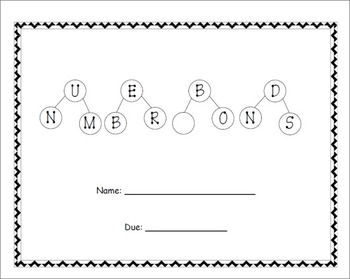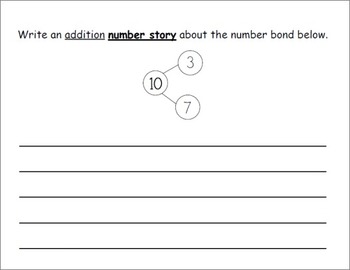Number Bonds - Common Core Take-home Math Project Grades K, 1, and 2
Kelly Beleckas
338 Followers
Grade Levels
PreK - 2nd
Subjects
Resource Type
Formats Included
- PDF
Pages
13 pages
Kelly Beleckas
338 Followers
Description
Using number bonds in K-2 classrooms is a great way to help students understand part-whole relationships at an early age. If students understand how to compose and decompose numbers easily, they will be able to break apart numbers and find compatible numbers when doing “mental math” in addition and subtraction, strategies required by the Common Core.
This take-home project includes 13 pages. Depending on your needs and your students’ needs, you can choose to include all pages or just some pages.
Page 1 – Title page
Page 2 – Example (for students AND parents to follow)
Page 3 – Number bonds for students to complete that have most parts completed already
Page 4 – Number bonds for students to complete that have some parts completed already
Page 5 – Number bonds for students to complete that have some parts completed already
Page 6 – Students must draw their own number bonds to show a given number (a hint is provided about how many number bonds students should have in all)
Page 7 – Students must draw their own number bonds to show a given number (a hint is provided about how many number bonds students should have in all)
Page 8 – Students must draw their own number bonds to show a given number (a hint is provided about how many number bonds students should have in all)
Page 9 – Students must draw their own number bonds to show a given number (a hint is provided about how many number bonds students should have in all)
Page 10 – Students must draw their own number bonds to show a given number (a hint is provided about how many number bonds students should have in all)
Page 11 – Students must write an addition number story that matches a given number bond
Page 12 – Students must write a subtraction number story that matches a given number bond
Page 13 – Students are given a number bond and must write 2 addition sentences and 2 subtraction sentences that match the number bond (a fact family)
This activity is great to assign as a take-home project in any classroom. It is great to send take-home projects in math to help parents see what is expected of students in the Common Core standards as well as what strategies and terms are being used in the classroom. When assigning this project to students in younger grades OR when looking for a way to differentiate, try giving students a bag with red/yellow counters to manipulate when composing and decomposing numbers. You can also use rekenreks or any other types of counters. Since the project comes with so many pages, you can even have students complete some pages in school and some at home.
The following common core math standards are addressed in this project:
K.CC.3. Write numbers from 0 to 20. Represent a number of objects with a written numeral 0-20 (with 0 representing a count of no objects).
K.OA.1. Represent addition and subtraction with objects, fingers, mental images, drawings, sounds (e.g., claps), acting out situations, verbal explanations, expressions, or equations.
K.OA.2. Solve addition and subtraction word problems, and add and subtract within 10, e.g., by using objects or drawings to represent the problem.
K.OA.3. Decompose numbers less than or equal to 10 into pairs in more than one way, e.g., by using objects or drawings, and record each decomposition by a drawing or equation (e.g., 5 = 2 + 3 and 5 = 4 + 1).
1.OA.1. Use addition and subtraction within 20 to solve word problems involving situations of adding to, taking from,
putting together, taking apart, and comparing, with unknowns in all positions, e.g., by using objects, drawings, and equations with a symbol for the unknown number to represent the problem.
1.OA.2. Solve word problems that call for addition of three whole numbers whose sum is less than or equal to 20, e.g., by using objects, drawings, and equations with a symbol for the unknown number to represent the problem.
1.OA.3. Apply properties of operations as strategies to add and subtract. Examples: If 8 + 3 = 11 is known, then 3 + 8 = 11 is also known. (Commutative property of addition.) To add 2 + 6 + 4, the second two numbers can be added to make a ten, so 2 + 6 + 4 = 2 + 10 = 12. (Associative property of addition.)
1.OA.5. Relate counting to addition and subtraction (e.g., by counting on 2 to add 2).
1.OA.6. Add and subtract within 20, demonstrating fluency for addition and subtraction within 10. Use strategies such as counting on; making ten (e.g., 8 + 6 = 8 + 2 + 4 = 10 + 4 = 14); decomposing a number leading to a ten (e.g., 13 – 4 = 13 – 3 – 1 = 10 – 1 = 9); using the relationship between addition and subtraction (e.g., knowing that 8 + 4 = 12, one knows 12 – 8 = 4); and creating equivalent but easier or known sums (e.g., adding 6 + 7 by creating the known equivalent 6 + 6 + 1 = 12 + 1 = 13).
1.OA.8. Determine the unknown whole number in an addition or subtraction equation relating three whole numbers. For example, determine the unknown number that makes the equation true in each of the equations 8 + ? = 11, 5 = _ –
3, 6 + 6 = _.
2.OA.1. Use addition and subtraction within 100 to solve one- and two-step word problems involving situations of adding to, taking from, putting together, taking apart, and comparing, with unknowns in all positions, e.g., by using drawings and equations with a symbol for the unknown number to represent the problem.
2.OA.2. Fluently add and subtract within 20 using mental strategies (1.OA.6). By end of Grade 2, know from memory all sums of two one-digit numbers.
This take-home project includes 13 pages. Depending on your needs and your students’ needs, you can choose to include all pages or just some pages.
Page 1 – Title page
Page 2 – Example (for students AND parents to follow)
Page 3 – Number bonds for students to complete that have most parts completed already
Page 4 – Number bonds for students to complete that have some parts completed already
Page 5 – Number bonds for students to complete that have some parts completed already
Page 6 – Students must draw their own number bonds to show a given number (a hint is provided about how many number bonds students should have in all)
Page 7 – Students must draw their own number bonds to show a given number (a hint is provided about how many number bonds students should have in all)
Page 8 – Students must draw their own number bonds to show a given number (a hint is provided about how many number bonds students should have in all)
Page 9 – Students must draw their own number bonds to show a given number (a hint is provided about how many number bonds students should have in all)
Page 10 – Students must draw their own number bonds to show a given number (a hint is provided about how many number bonds students should have in all)
Page 11 – Students must write an addition number story that matches a given number bond
Page 12 – Students must write a subtraction number story that matches a given number bond
Page 13 – Students are given a number bond and must write 2 addition sentences and 2 subtraction sentences that match the number bond (a fact family)
This activity is great to assign as a take-home project in any classroom. It is great to send take-home projects in math to help parents see what is expected of students in the Common Core standards as well as what strategies and terms are being used in the classroom. When assigning this project to students in younger grades OR when looking for a way to differentiate, try giving students a bag with red/yellow counters to manipulate when composing and decomposing numbers. You can also use rekenreks or any other types of counters. Since the project comes with so many pages, you can even have students complete some pages in school and some at home.
The following common core math standards are addressed in this project:
K.CC.3. Write numbers from 0 to 20. Represent a number of objects with a written numeral 0-20 (with 0 representing a count of no objects).
K.OA.1. Represent addition and subtraction with objects, fingers, mental images, drawings, sounds (e.g., claps), acting out situations, verbal explanations, expressions, or equations.
K.OA.2. Solve addition and subtraction word problems, and add and subtract within 10, e.g., by using objects or drawings to represent the problem.
K.OA.3. Decompose numbers less than or equal to 10 into pairs in more than one way, e.g., by using objects or drawings, and record each decomposition by a drawing or equation (e.g., 5 = 2 + 3 and 5 = 4 + 1).
1.OA.1. Use addition and subtraction within 20 to solve word problems involving situations of adding to, taking from,
putting together, taking apart, and comparing, with unknowns in all positions, e.g., by using objects, drawings, and equations with a symbol for the unknown number to represent the problem.
1.OA.2. Solve word problems that call for addition of three whole numbers whose sum is less than or equal to 20, e.g., by using objects, drawings, and equations with a symbol for the unknown number to represent the problem.
1.OA.3. Apply properties of operations as strategies to add and subtract. Examples: If 8 + 3 = 11 is known, then 3 + 8 = 11 is also known. (Commutative property of addition.) To add 2 + 6 + 4, the second two numbers can be added to make a ten, so 2 + 6 + 4 = 2 + 10 = 12. (Associative property of addition.)
1.OA.5. Relate counting to addition and subtraction (e.g., by counting on 2 to add 2).
1.OA.6. Add and subtract within 20, demonstrating fluency for addition and subtraction within 10. Use strategies such as counting on; making ten (e.g., 8 + 6 = 8 + 2 + 4 = 10 + 4 = 14); decomposing a number leading to a ten (e.g., 13 – 4 = 13 – 3 – 1 = 10 – 1 = 9); using the relationship between addition and subtraction (e.g., knowing that 8 + 4 = 12, one knows 12 – 8 = 4); and creating equivalent but easier or known sums (e.g., adding 6 + 7 by creating the known equivalent 6 + 6 + 1 = 12 + 1 = 13).
1.OA.8. Determine the unknown whole number in an addition or subtraction equation relating three whole numbers. For example, determine the unknown number that makes the equation true in each of the equations 8 + ? = 11, 5 = _ –
3, 6 + 6 = _.
2.OA.1. Use addition and subtraction within 100 to solve one- and two-step word problems involving situations of adding to, taking from, putting together, taking apart, and comparing, with unknowns in all positions, e.g., by using drawings and equations with a symbol for the unknown number to represent the problem.
2.OA.2. Fluently add and subtract within 20 using mental strategies (1.OA.6). By end of Grade 2, know from memory all sums of two one-digit numbers.
Total Pages
13 pages
Answer Key
N/A
Teaching Duration
N/A
Report this resource to TPT
Reported resources will be reviewed by our team. Report this resource to let us know if this resource violates TPT’s content guidelines.




